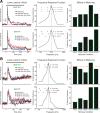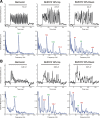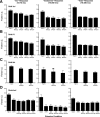Neural correlates of auditory scene analysis based on inharmonicity in monkey primary auditory cortex
- PMID: 20844143
- PMCID: PMC3641774
- DOI: 10.1523/JNEUROSCI.1780-10.2010
Neural correlates of auditory scene analysis based on inharmonicity in monkey primary auditory cortex
Abstract
Segregation of concurrent sounds in complex acoustic environments is a fundamental feature of auditory scene analysis. A powerful cue used by the auditory system to segregate concurrent sounds, such as speakers' voices at a cocktail party, is inharmonicity. This can be demonstrated when a component of a harmonic complex tone is perceived as a separate tone "popping out" from the complex as a whole when it is sufficiently mistuned from its harmonic value. The neural bases of perceptual "pop out" of mistuned harmonics are unclear. We recorded multiunit activity from primary auditory cortex (A1) of behaving monkeys elicited by harmonic complex tones that were either "in tune" or that contained a mistuned third harmonic set at the best frequency of the neural populations. Responses to mistuned sounds were enhanced relative to responses to "in-tune" sounds, thus correlating with the enhanced perceptual salience of the mistuned component. Consistent with human psychophysics of "pop out," response enhancements increased with the degree of mistuning, were maximal for neural populations tuned to the frequency of the mistuned component, and were not observed under comparable stimulus conditions that do not elicit perceptual "pop out." Mistuning was also associated with changes in neuronal temporal response patterns phase locked to "beats" in the stimuli. Intracortical auditory evoked potentials paralleled noninvasive neurophysiological correlates of perceptual "pop out" in humans, further augmenting the translational relevance of the results. Findings suggest two complementary neural mechanisms for "pop out," based on the detection of local differences in activation level or coherence of temporal response patterns across A1.
Figures













References
-
- Alain C, Arnott SR, Picton TW. Bottom-up and top-down influences on auditory scene analysis: evidence from event-related brain potentials. J Exp Psychol Hum Percept Perform. 2001;27:1072–1089. - PubMed
-
- Alain C, Schuler BM, McDonald KL. Neural activity associated with distinguishing concurrent auditory objects. J Acoust Soc Am. 2002;111:990–995. - PubMed
-
- Arezzo JC, Vaughan HG, Jr, Kraut MA, Steinschneider M, Legatt AD. Intracranial generators of event-related potentials in the monkey. In: Cracco RQ, Bodis-Wollner I, editors. Frontiers of clinical neuroscience: evoked potentials. Vol 3. New York: Liss; 1986. pp. 174–189.
-
- Bieser A, Müller-Preuss P. Auditory responsive cortex in the squirrel monkey: neural responses to amplitude-modulated sounds. Exp Brain Res. 1996;108:273–284. - PubMed
Publication types
MeSH terms
Grants and funding
LinkOut - more resources
Full Text Sources
Molecular Biology Databases
